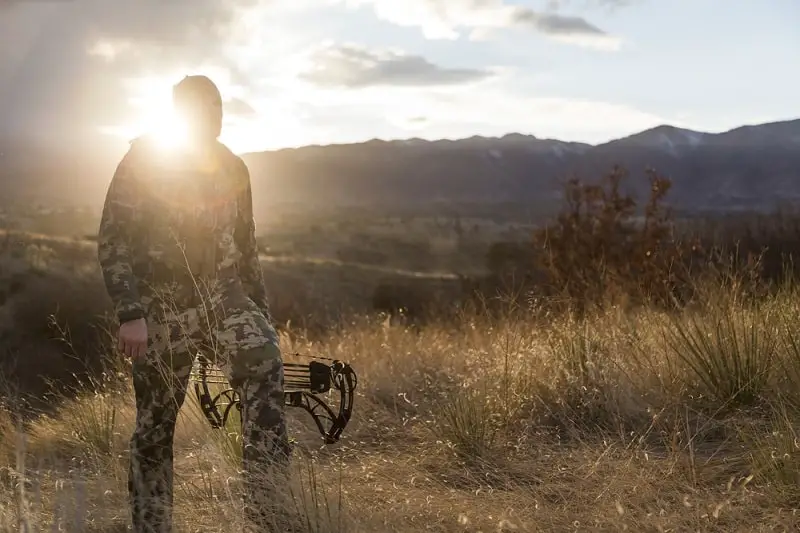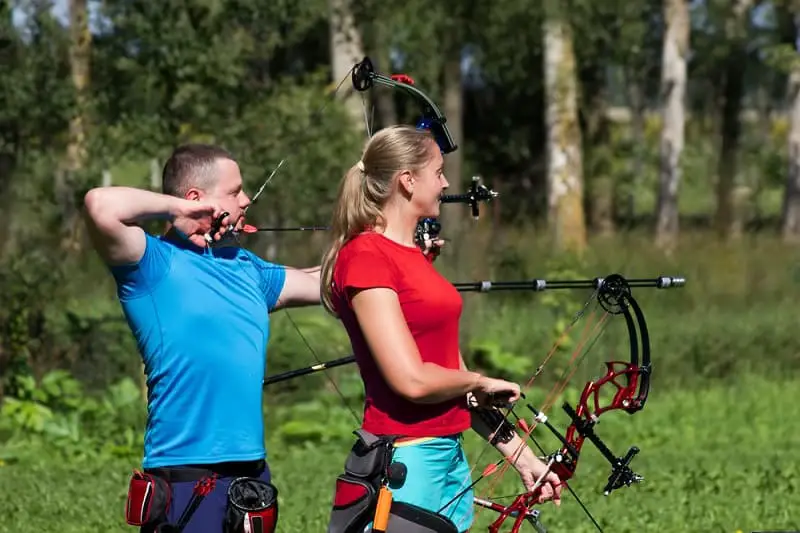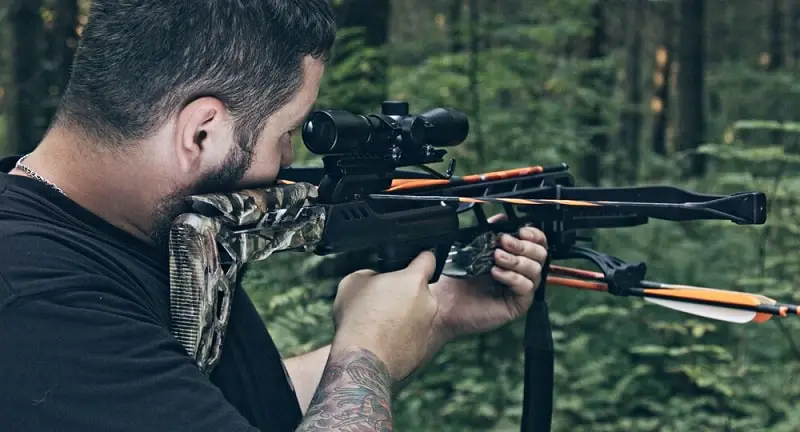
Today, more so than ever, many options exist for those wishing to head to the woods with one form of archery tackle or another. Of the many options available, crossbows and compound bows are some of the most popular.
Hunters who take either of these two weapons to the woods have their reasons, and opinions often differ on the pros and cons of both. However, much like the age-old discussion between gun and bowhunters, the choice between a crossbow and compound bow often comes down to personal preference.
The following article is an unbiased look at what makes these two hunting styles so popular. It offers a glimpse into what a new archer should know before deciding which road to travel.
Compound Bow

Compound Bow History
The compound bow has been around since the 1960s, invented by Holless Wilbur Allen. Allen put a new spin on traditional bows—like longbows or recurve bows—by fitting his bow with a system of cams and eccentric wheels. This early compound bow allowed archers to hold their bowstring at full draw with far less effort.
This idea was somewhat slow to gain traction due to a lack of interest from manufacturers and consumers alike. By the late 1960s, outdoor writer and archery enthusiast, Tom Jennings, became interested in the compound bow. He applied to license Allen’s concept, and soon began producing compound bows. He marketed them under the Jennings name.
Within a few short years, Jennings released the now legendary Model-T compound bow. It featured an independent wheel at each limb’s tip, instead of several wheels and cams found on Allen’s original prototype. The Model-T was a hit, and soon Jennings found himself working in earnest to keep up with demand.
In the mid-1970s, many manufacturers threw their hats into the ring and began producing compound bows. With every year that passed, the compound bow’s popularity for hunting and target shooting continued to grow.
Compound Bow Features
Today, many archers choose compound bows over other vertical bows due to their efficiency and adjustability.
Speed
The bulk of modern compound bows can propel arrows downrange at speeds above 300 FPS, with many now approaching or exceeding the 350 FPS mark.
This speed creates a flatter trajectory than most conventional bows such as recurve or longbows. This is a big help when deer hunting or shooting at any other game. Longbows or recurve bows simply cannot touch the performance of modern compound bows.
Adjustability
Modern compound bows are also popular thanks to their adjustability. Granted, adjustable draw length and weight ranges have been available for years. But, ultra-adjustable compound bows have flooded the market in the last decade.
Many well-known manufacturers are marketing highly-adjustable bows. These companies include names like Bear Archery, Diamond Archery, and PSE. Some of these bows have 50-plus pounds of draw weight adjustability and as much as 15-inches in draw length adjustability. This has been a real game-changer, as a bow can now “grow” with young archers as they make their way into adulthood.
Quietness
Compound bows of the modern era are also notably quiet to shoot, even when delivering arrows downrange at extreme speeds.
Even with these modern conveniences, the job’s not easy. The compound bow still requires the technique, patience, and skill to draw a bow while close to a deer or other game.
Crossbow

Crossbow History
A crossbow is a hybrid between a gun and a bow. These weapons feature a horizontally-mounted bow, attached to a stock-mounted rail system. A crossbow cocks into position with a cocking device. It stays at full draw until the archer pulls the trigger.
Archers refer to crossbow arrows as bolts. They’re generally shorter in length than compound bow arrows. When fired, the bolt travels along the rail and exits the crossbow.
The history of crossbow use dates back several centuries, used as a weapon of war in China. Though archers probably used them to hunt as well, it wasn’t as popular as it is today. Modern crossbow hunting did not see a significant rise in popularity until the 1960s.
At that time, a mix of vertical bow and specialized crossbow manufacturers jumped onboard. They began ramping up production of the modern crossbow. They also began pushing for their inclusion within archery seasons nationwide. Though many states allow crossbows during gun season, some allow them throughout all seasons.
Crossbow Features
Crossbow types
Crossbows come in two forms; compound crossbows and recurve crossbows. Compound crossbows feature cam and idler pulleys. Much like their vertical counterparts, these pulleys create incredible arrow speeds. Recurve crossbows feature standard recurve limbs like traditional vertical bows.
Scopes
Many crossbow shooters now use specialized crossbow scopes, which allow them to hone in on game at 50 yards or more. These scopes weren’t a necessity in the past. Significant advancements in crossbow technology have stretched their effective range. They now require decent optics to take advantage of this range.
Speed
Many modern crossbows fire bolts at blistering speeds over 400 FPS. This speed creates a flatter trajectory to work with. This makes it possible to take shots that would be difficult with a compound bow, without significant compensation for arrow drop.
No need to draw before shooting
One factor worth mentioning is that hunters don’t have to draw their crossbow while under the watchful eye of game. When reaching your blind or stand, you can cock your crossbow and place an arrow onto its rail. This allows a hunter to prepare for the shot in much the same way as when gun hunting.
Less strength required
Crossbows are also an excellent tool for introducing the next generation of young outdoorsmen and women to hunting. While many youngsters aren’t strong enough to draw a bow, an adult can cock a crossbow for them. The child can then hunt without any extra movement.
Crossbows also allow aging or disabled hunters to experience the wonders of the deer woods. Arm, shoulder, and back injuries can often be debilitating for an archer. These issues can bring an individual’s archery career to an end. Hunters in this category can use a crossbow to get back into the woods.
How They Stack Up
The decision to hunt with a crossbow or compound bow comes down to a matter of personal preference. However, the following section outlines how these two weapons compare to each other.
Speed
When comparing arrow and bolt speeds between compound bows and crossbows, the edge goes to the crossbow. Many crossbows now advertise speeds over 450 FPS, while the fastest compound bows achieve arrow speeds of up to 350 FPS.
This difference in speed is due to crossbows having higher draw weights than most compound bows. Many crossbows have full cocking weights of 150 pounds, while 70 pounds tends to be the ceiling for most compound bows.
Advantage: Crossbow
Ease of Use
When considering how easy a weapon is to use, the crossbow once again has a significant edge. Once an archer cocks their crossbow, they can aim and fire it the same way as a rifle. On the other hand, an archer has to draw a compound bow back before taking aim—a challenge when hiding from a big buck.
Some bowhunters hunt with archery tackle for the challenge while others use archery tackle purely to extend their season. If you’re part of the latter group, you’ll enjoy a crossbow.
However, taking a great deer with a crossbow is no less of an accomplishment than would be the case when taken with a compound bow.
Advantage: Crossbow
Weight
An outfitted modern compound bow generally weighs half that of a crossbow, typically tipping the scales somewhere between four to five pounds. For comparison, the bulk of compound crossbows weigh in at around seven or eight pounds, though a few are available that are a bit lighter.
This weight is fine if you don’t have to trek very far off of the beaten path to reach your ground blind or treestand. However, if you have to hike a mile to escape hunting pressure, this may be a significant factor in your decision.
Advantage: Compound Bow
Overall Experience
When solely comparing performance numbers, a crossbow, by design, will trump a compound bow every time. However, this does not always tell the whole story.
There is something special to say for drawing your bow and executing a shot on a wary whitetail 20 yards away. If you haven’t experienced this, put it on your bucket list. There is little in life that will produce such an adrenaline rush. While crossbow hunting is thrilling, it cannot measure up to the experience of taking game with a vertical bow.
The Great Debate – Should Crossbows Be Allowed in Archery Season?
No discussion regarding crossbows and compound bows would be complete without addressing the elephant in the room. In recent years, there has been a lot of chatter on whether crossbows should be legal for use during general archery seasons from one state to the next.
Some bowhunters claim that those using a crossbow have an unfair advantage over vertical bowhunters. However, many crossbow hunters maintain that any hunting weapon that fires an arrow is a bow by definition.
In recent years, most fish and wildlife agencies have green-lighted crossbows for use during regular archery seasons. The bulk of those that haven’t done so offer special crossbow-only seasons.
Still, the debate rages on. The argument itself draws aggravation and heated responses from both sides. This division is far more troubling than the debate itself.
Hunting draws fire from many activist groups. Anti-hunting groups continue to lobby for bans on hunting and the closing of seasons.
As hunters, we must ask ourselves: Is in-fighting over a weapon worth a rift that could lead to the demise of the sport we love?
The logical stance would be for all hunters to support the clean and ethical harvest of game, no matter the choice of legal weapon. We stand a greater chance of preserving our heritage if we set aside our differences. We need to focus on our common ground.
After all, aging generations of hunters are dropping from our ranks, and new hunter recruitment is at an all-time low. Can we stand to pick and choose how we introduce new hunters to the sport? We can all agree that introducing children to the great outdoors and keeping the aging among us in the woods is more important.
